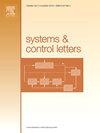Harnessing optimal robustness towards PI regulators of linear perturbed unstable systems
IF 2.5
3区 计算机科学
Q3 AUTOMATION & CONTROL SYSTEMS
引用次数: 0
Abstract
In this paper, we investigate how a regulator can be implemented for gaining the optimal robustness margin of second-order plants in the presence of uncertain perturbations. We are primarily interested in an intricate system, i.e., the second-order unstable plant with a zero relative degree that is accompanied by at least one unstable pole and non-minimum phase dynamics, both implemented by the proportional and proportional–integral (PI) type regulators. More specifically, we shall examine three scenarios of the system ranging from the worst case of two unstable poles and two minimum phase zeros to the case of one unstable pole and one minimum phase zero. For each class of systems, we furnish the bi-dimensional feasible horizons for the controller parameters of PI regulators. Drawing upon the feasible domains, we derive the explicit expressions of the optimal robustness margin against unknown uncertainties. Beyond that, we determine the regulator parameters for accomplishing the maximum margins, i.e., the optimum proportional and integral gains. At last, we extend to explore the optimum robustness margin achievable with a PI regulator for third-order non-minimum phase systems. Our results illustrate that the optimal robustness margins obtainable are dependent on the locations of the system’s unstable poles and non-minimum phase dynamics while attaining the optimized margin is relevant to the control parameters of the PI regulator, thus casting insight upon the design and adaptation of the regulator parameters.
利用线性摄动不稳定系统的PI调节器的最优鲁棒性
在本文中,我们研究了在不确定扰动存在的情况下,如何实现一个调节器来获得二阶植物的最优鲁棒裕度。我们主要对一个复杂的系统感兴趣,即具有零相对度的二阶不稳定植物,伴随着至少一个不稳定极点和非最小相位动力学,两者都由比例和比例积分(PI)型调节器实现。更具体地说,我们将研究系统的三种情况,从两个不稳定极点和两个最小相零的最坏情况到一个不稳定极点和一个最小相零的情况。对于每一类系统,我们给出了PI调节器的控制器参数的二维可行范围。在可行域的基础上,导出了针对未知不确定性的最优鲁棒裕度的显式表达式。除此之外,我们还确定了实现最大边际的调节器参数,即最佳比例增益和积分增益。最后,我们进一步探讨了用PI调节器对三阶非最小相位系统可实现的最优鲁棒裕度。我们的研究结果表明,可获得的最优鲁棒裕度取决于系统不稳定极点和非最小相位动力学的位置,而获得最优裕度与PI调节器的控制参数有关,从而对调节器参数的设计和自适应有了深入的了解。
本文章由计算机程序翻译,如有差异,请以英文原文为准。
求助全文
约1分钟内获得全文
求助全文
来源期刊

Systems & Control Letters
工程技术-运筹学与管理科学
CiteScore
4.60
自引率
3.80%
发文量
144
审稿时长
6 months
期刊介绍:
Founded in 1981 by two of the pre-eminent control theorists, Roger Brockett and Jan Willems, Systems & Control Letters is one of the leading journals in the field of control theory. The aim of the journal is to allow dissemination of relatively concise but highly original contributions whose high initial quality enables a relatively rapid review process. All aspects of the fields of systems and control are covered, especially mathematically-oriented and theoretical papers that have a clear relevance to engineering, physical and biological sciences, and even economics. Application-oriented papers with sophisticated and rigorous mathematical elements are also welcome.
 求助内容:
求助内容: 应助结果提醒方式:
应助结果提醒方式:


